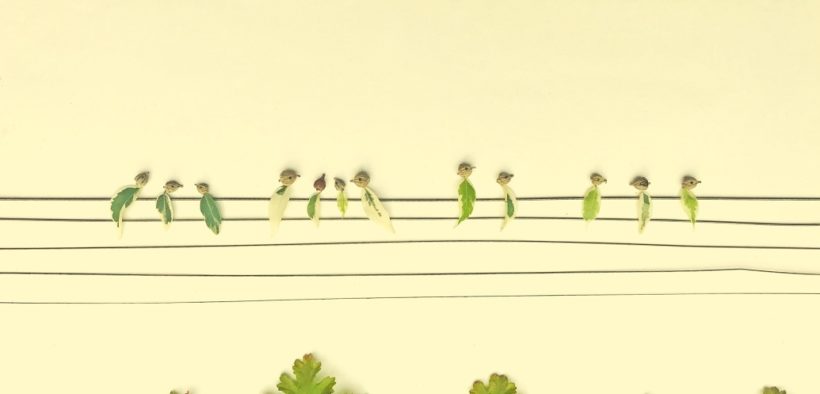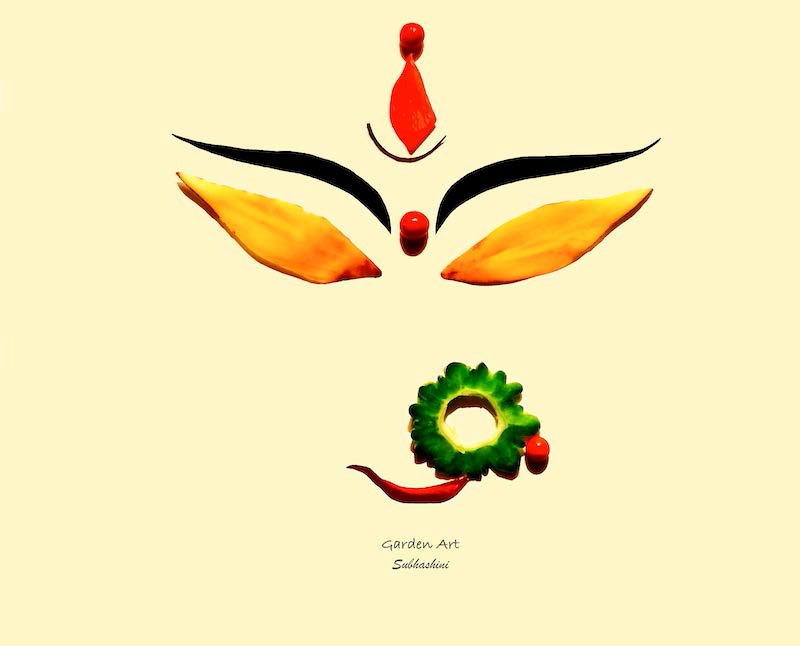Painting With Flowers

Subhashini Chandramani’s garden art evokes a sense of the unreal within the familiar.
Where most of us might turn to the canvas or paper to express ourselves, Subhashini Chandramani chose something different: she uses flowers. In what she has come to name as ‘Garden Art’, Chandramani uses flowers instead of colors to create unique patterns and designs. Once acquainted, one can see why her process is layered and fascinating. A large part of her work with a particular idea or design is intuitive.
When she begins, there’s mostly only the predominant desire to create something, anything. Slowly, the idea takes shape and as it develops its contours, she goes out to her garden in search of flowers that will soon manifest into a flamenco skirt, a nose ring or maybe, as could be seen in her latest work done, especially for WeCanServe, a flowering brain.
Interestingly, Chandramani started out the traditional way. She loved to sketch and continued doing so into adulthood. One day, as she was finishing the portrait of a woman, she impulsively tried placing a bougainvillea flower where the nose ring was meant to be. It fit perfectly! That served as the breakthrough moment for what has become a practice in full blossom.
Chandramani does not buy flowers for her use. She grows them in her lush garden. Taking care of the plants itself is an integral part of the process for her. “I’ve learned so much by being close to the wonderment of nature,” she says. “Earlier, I used to look at flowers just as everybody else does. That casual acknowledgment changed as I began my practice with flowers. These days, when I enter my garden, I feel that I’m in a conversation with every plant in my garden. Even without checking, I know which plants need watering and which one is asking for my loving attention.” It sure does sound like an experience in Zen and with good reason.
Chandramani is a huge admirer of Zen aesthetics, especially of haiku (short, three-line Japanese poems). She particularly finds Taigu Ryokan’s haikus arresting. Ask her why and she says it’s the honesty in his work: “You see, he goes through all these seasons alone and constantly realigns himself to the way. His poems embody emotional honesty and a creative response to experience, to what he was going through in life. It inspires me, and my own process.”
That brings us to her other creative facets. Apart from her art practice, she is also a published poet, with two collections of poetry to her credit. Her practice of art and poetry is quite symbiotic. For her, both poetry and art are about “extending the time and space available to you to create” and playing with the many possibilities that are available. “My work with flowers feels like experiencing a haiku. It is minimal and is very much about capturing the essence of the image, maintaining only what is necessary. Perhaps one can call it “extravagance within an economy of words.”
Besides writing poetry, Chandramani has recently forayed into designing book covers. Her latest is Kat Lehmann’s Small Stones From The River. She loves challenging tasks and would like to do more as and when time permits. I find it the right time to bring up the ephemeral quality of her garden art. Unlike other mediums, leaves and flowers often do not last the day. How does she afford to retain the work? “Photography, of course,” she says. Once a work is finished, she uses her iPhone to capture the image. These unedited images are then displayed in her online store and an Instagram feed. It is these images that are then purchased by customers. “I feel that photographing the work adds another layer to them, in terms of the effects created by shadows and light. I’m quite fascinated by their charismatic effect.”
She says that her practice has certainly deepened her inner experience over time. Even her spending patterns have changed. No more jewelry and feel-good buys. Most of her investment goes into the garden, which is, of course, her primary material and creative haven. “Flowers soothe my nerves,” she says. “They also make me more aware of what is passing around me. I can feel the seasons better now. And there’s this priceless sense of companionship.”
For Chandramani, her family remains both her greatest support system and a group of critics. If something doesn’t get past them, it goes back for rework. She also doesn’t believe in competition, except with her own limits. She does it for the strokes of happiness it brings, which is entire of her making and belongs only to her. Inspired by her own unique process, she remains open to interesting collaborations, yet nothing is charted. It is as it unfolds. Well, for all we know, that’s probably how it is to be like a flower.

Buddham Charanam Gaccami
Where Buddha meditates beneath a broccoli tree

Flowers are flowhers! Made with the yellow
chrysanthemun flower

Flowers are flowhers! Made with the yellow
chrysanthemun flower

Created with a watergun and petals of the
colourful chrysanthemum as coloured water

Created with butterfly pea/sangupushpam/
aparajitha

The eyebrows are undoubtedly the most
defining part of the face; here, it gets a
feathery touch

Jasmine rice, chrysanthemum avial, hibiscus
poppadoms, filaments of flowers as semiya payasam,
frangipani banana chips, champaka injipuli, dahlia
beetroot, cabbage curry, yellow bell morkuzhambu
and moonbeam pachadi

Happiness stems from the brain; created with the
stamens of the pumpkin flower
















